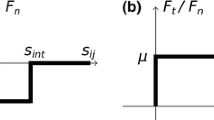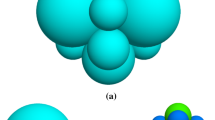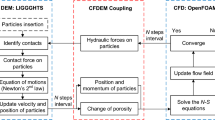Abstract
The paper reports the application of a 3-D direct particle–fluid simulation model to the seepage failure of granular soils. The goal of this study is to numerically capture the process of the failure which is induced by the seepage flow from the micromechanical aspects with no macroscopic assumptions. In order to accomplish this goal, non-cohesive granular assemblies with an upward seepage flow and a variety of pressure gradients are investigated. The motion and the collision of the soil particles are calculated by a soft sphere model, such as the discrete element method, and the flow of the pore fluid is directly solved at a smaller scale than the diameter of the soil particles by the lattice Boltzmann method. By coupling these methods, the interaction between the soil particles and the seepage flow is also considered. As a result of the series of analyses, the numerically predicted value for the critical hydraulic gradient is found to be in good agreement with the theoretical value. In addition, the rapid change in the flow pattern around the critical hydraulic gradient can be microscopically captured. By observing the evolution of the force chains inside the soils, it is demonstrated that the failure process of the contact networks can also be reproduced by the simulation model presented here.










Similar content being viewed by others
References
Van der Hoef MA, van Sint Annaland M, Deen NG, Kuipers JAM (2008) Numerical simulation of dense gas-solid fluidized beds: a multiscale modeling strategy. Annu Rev Fluid Mech 40:47–70
Tsuji Y, Kawaguchi T, Tanaka T (1993) Discrete particle simulation of two-dimensional fluidized bed. Powder Technol 77(1):79–87
Glowinski R, Pan TW, Hesla TI, Joseph DD, Periaux J (2001) A fictitious domain approach to the direct numerical simulation of incompressible viscous flow past moving rigid bodies: application to particulate flow. J Comput Phys 169(2):363–426
Gallier S, Lemaire E, Lobry L, Peters F (2014) A fictitious domain approach for the simulation of dense suspensions. J Comput Phys 256:367–387
Yu Z, Shao X (2007) A direct-forcing fictitious domain method for particulate flows. J Comput Phys 227(1):292–314
Abdelhamid Y, Shamy UE (2014) Pore-scale modeling of surface erosion in a particle bed. Int J Numer Anal Methods Geomech 38(2):142–166
Boutt DF, Cook BK, Williams JR (2011) A coupled fluid–solid model for problems in geomechanics: application to sand production. Int J Numer Anal Methods Geomech 35(9):997–1018
Catalano E, Chareyre B, Barthélémy E (2014) Pore-scale modeling of fluid-particles interaction and emerging poromechanical effects. Int J Numer Anal Methods Geomech 38(1):51–71
Topin V, Monerie Y, Perales F, Radjaï F (2012) Collapse dynamics and runout of dense granular materials in a fluid. Phys Rev Lett 109(18):188001
Larese A, Rossi R, Oñate E, Idelsohn SR (2012) A coupled PFEM–Eulerian approach for the solution of porous FSI problems. Comput Mech 50(6):1–15
Becker P, Idelsohn SR, Oñate E (2015) A unified monolithic approach for multi-fluid flows and fluid–structure interaction using the particle finite element method with fixed mesh. Comput Mech 55(6):1091–1104
Bandara S, Soga K (2015) Coupling of soil deformation and pore fluid flow using material point method. Comput Geotech 63:199–214
Qian YH, D’Humiéres D, Lallemand P (1992) Lattice BGK models for Navier–Stokes equation. Europhys Lett 17:479
McLennan JA (1965) Convergence of the Chapman–Enskog expansion for the linearized Boltzmann equation. Phys Fluids (1958–1988) 8(9):1580–1584
Sone Y (1971) Asymptotic theory of flow of a rarefied gas over a smooth boundary II. In: IXth international symposium on rarefied gas dynamics. Editrice Tecnico Scientifica, Pisa, pp 737–749
Reider MB, Sterling JD (1995) Accuracy of discrete-velocity BGK models for the simulation of the incompressible Navier–Stokes equations. Comput Fluids 24(4):459–467
Noble DR, Torczynski JR (1998) A lattice-Boltzmann method for partially saturated computational cells. Int J Mod Phys C 9(08):1189–1201
Owen DR, Leonardi CR, Feng YT (2011) An efficient framework for fluid–structure interaction using the lattice Boltzmann method and immersed moving boundaries. Int J Numer Anal Methods Eng 87(1–5):66–95
Han Y, Cundall PA (2011) Lattice Boltzmann modeling of pore-scale fluid flow through idealized porous media. Int J Numer Anal Methods Fluids 67(11):1720–1734
Strack OE, Cook BK (2007) Three-dimensional immersed boundary conditions for moving solids in the lattice-Boltzmann method. Int J Numer Anal Methods Fluids 55(2):103–125
Ladd AJ (1994) Numerical simulations of particulate suspensions via a discretized Boltzmann equation. Part 1. Theoretical foundation. J Fluid Mech 271:285–309
Ladd AJ (1994) Numerical simulations of particulate suspensions via a discretized Boltzmann equation. Part 2. Numerical results. J Fluid Mech 271:311–339
Feng ZG, Michaelides EE (2004) The immersed boundary-lattice Boltzmann method for solving fluid–particles interaction problems. J Comput Phys 195(2):602–628
Chen L, Yu Y, Hou G (2013) Sharp-interface immersed boundary lattice Boltzmann method with reduced spurious-pressure oscillations for moving boundaries. Phys Rev E 87(5):053306
Cundall PA, Strack OD (1979) A discrete numerical model for granular assemblies. Geotechnique 29(1):47–65
Singh P, Hesla TI, Joseph DD (2003) Distributed lagrange multiplier method for particulate flows with collisions. Int J Multiph Flow 29:495–509
Wachs A (2009) A DEM-DLM/FD method for direct numerical simulation of particulate flows: sedimentation of polygonal isometric particles in a Newtonian fluid with collisions. Comput Fluids 38(8):1608–1628
Ding EJ, Aidun CK (2003) Extension of the lattice-Boltzmann method for direct simulation of suspended particles near contact. J Stat Phys 112(3–4):685–708
Yeo K, Maxey MR (2010) Simulation of concentrated suspensions using the force-coupling method. J Comput Phys 229(6):2401–2421
Sakaguchi H, Ozaki E, Igarashi T (1993) Plugging of the flow of granular materials during the discharge from a silo. Int J Mod Phys B 7:1949–1963
Fukumoto Y, Sakaguchi H, Murakami A (2013) The role of rolling friction in granular packing. Granul Matter 15(2):175–182
O’Sullivan C (2011) Particulate discrete element modelling: a geomechanics perspective. Taylor & Francis, New York
Zou Q, He X (1997) On pressure and velocity boundary conditions for the lattice Boltzmann BGK model. Phys Fluids 9(6):1591–1598
Ziegler DP (1993) Boundary conditions for lattice Boltzmann simulations. J Stat Phys 71(5–6):1171–1177
Ishihara K (2001) Soil mechanics, 2nd edn. Maruzen, Tokyo in Japanese
Han Y, Cundall PA (2011) Resolution sensitivity of momentum-exchange and immersed boundary methods for solid–fluid interaction in the lattice Boltzmann method. Int J Numer Methods Fluids 67(3):314–327
Mutabaruka P, Delenne JY, Soga K, Radjaï F (2014) Initiation of immersed granular avalanches. Phys Rev E 89(5):052203
Nishiura D, Sakaguchi H (2011) Parallel-vector algorithms for particle simulations on shared-memory multiprocessors. J Comput Phys 230(5):1923–1938
Nishiura D, Matsuo MY, Sakaguchi H (2014) ppohDEM: computational performance for open source code of the discrete element method. Comput Phys Commun 185(5):1486–1495
Wang X, Aoki T (2011) Multi-GPU performance of incompressible flow computation by lattice Boltzmann method on GPU cluster. Parallel Comput 37:521–535
D’Humieres D (2002) Multiple relaxation time lattice Boltzmann models in three dimensions. Philos Trans A Math Phys Eng Sci 360(1792):437–451
Inamuro T, Yoshino M, Ogino F (1999) Lattice Boltzmann simulation of flows in a three-dimensional porous structure. Int J Numer Anal Methods Fluids 29(7):737–748
Bird RB, Stewart WE, Lightfoot EN (1960) Transport phenomena. Wiley, Hoboken
Yu H, Girimaji SS, Luo LS (2005) DNS and LES of decaying isotropic turbulence with and without frame rotation using lattice Boltzmann method. J Comput Phys 209(2):599–616
Chen S, Doolen GD (1998) Lattice Boltzmann method for fluid flows. Annu Rev Fluid Mech 30(1):329–364
Inamuro T, Ogata T, Tajima S, Konishi N (2004) A lattice Boltzmann method for incompressible two-phase flows with large density differences. J Comput Phys 198(2):628–644
Acknowledgements
This work was supported by JSPS KAKENHI Grant Number 16K18146.
Author information
Authors and Affiliations
Corresponding author
Rights and permissions
About this article
Cite this article
Fukumoto, Y., Ohtsuka, S. 3-D direct numerical model for failure of non-cohesive granular soils with upward seepage flow. Comp. Part. Mech. 5, 443–454 (2018). https://doi.org/10.1007/s40571-017-0180-5
Received:
Revised:
Accepted:
Published:
Issue Date:
DOI: https://doi.org/10.1007/s40571-017-0180-5




